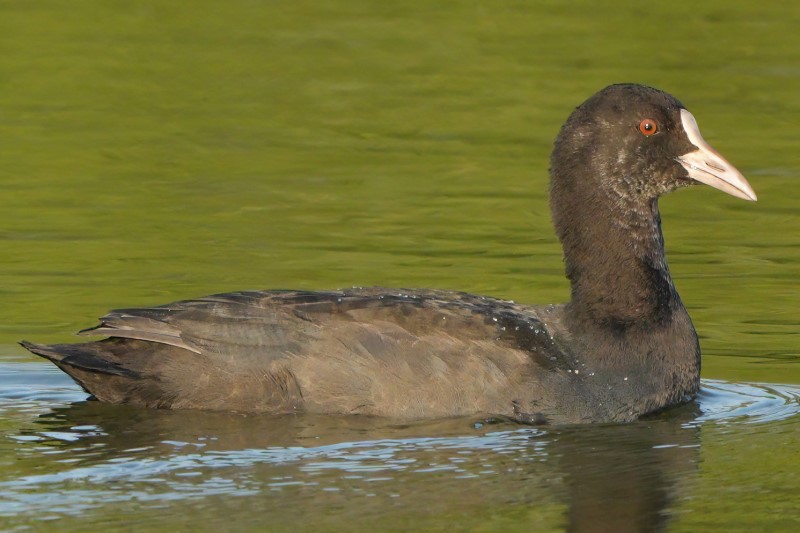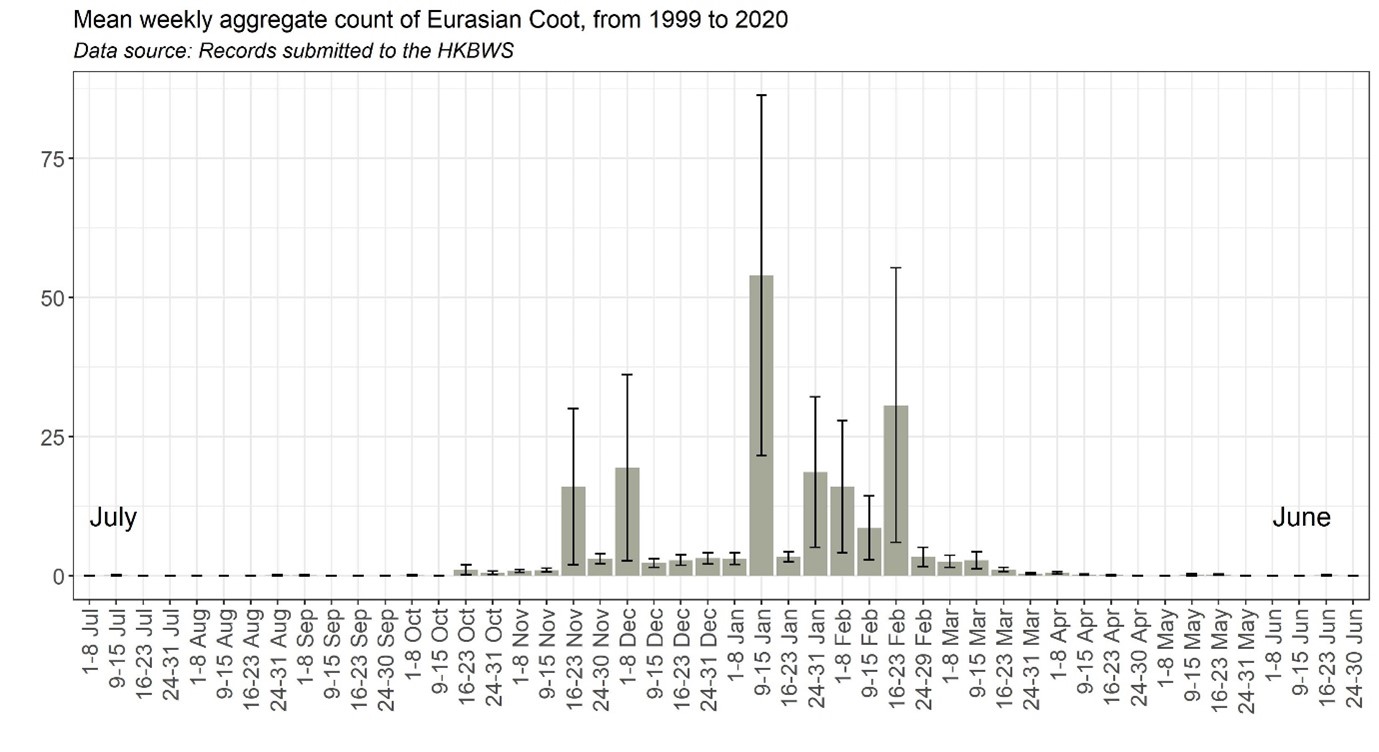Eurasian Coot Fulica atra 骨頂雞
Category I. Uncommon winter visitor to the Deep Bay area; very much declined since the 1990s.
IDENTIFICATION

Dec. 2010, Michelle and Peter Wong.
36-39 cm. Small to medium in size, compact and broad in the body, all dark with contrasting white bill and frontal shield; pale trailing edge to secondaries in flight. Usually jump dives into water. Very large, lobed yellow feet.

Dec. 2024, Paul Leader. First-winter.
36-39 cm. First-winter birds have olive-brown tinged upperparts and white-tipped feathers on the throat, cheeks and underparts. Adult bare part colours are acquired gradually.
VOCALISATIONS
The typical contact call is a short ‘kau’ or ‘kaup’:
Also utters a disyllabic falsetto note.
And a high-pitched ‘kik’ note.
DISTRIBUTION & HABITAT PREFERENCE
When Eurasian Coot was most numerous it occurred both on ponds inside Mai Po NR and the tidal waters along the coast from Nim Wan to Tsim Bei Tsui, as well as in Inner Deep Bay. High numbers could also be seen in certain fish pond areas, particularly San Tin. In contrast, this century, when numbers have been much lower, few Deep Bay records occurred in intertidal areas; the stiller waters of Mai Po NR, the MTRC wetland mitigation area at Lok Ma Chau and fish ponds have been favoured instead.
Since 1999 away from the Deep Bay area no more than five have been seen at a small number of sites mainly in the New Territories (particularly Long Valley and Shuen Wan). Single birds are occasionally seen on the sea in inshore waters.
OCCURRENCE
A winter visitor from mid-November to mid-March. In most years wintering birds have departed by the final week of April, while the first returning individuals are usually seen mid-October (Figure 1). Up to two birds are seen in summer in some years.
Herklots (1940) reported Eurasian Coot as being recorded in good numbers prior to 1939, though, oddly, 27 years later (Herklots 1967) he does not mention this, merely citing Vaughan and Jones (1913) on its historical abundance at Wang Mun, near Macau. From at least 1939 until 1955 it was not recorded at all, and only in winter 1970/71 were three-figure counts made, the highest in that winter being 450 in January. During the following winter numbers were much higher, with 2,600 present in early February 1972, though subsequently numbers were considerably lower.
By the mid-1980s it could be considered an abundant winter visitor; however, numbers of Eurasian Coot have greatly declined since the mid-1990s (Figure 2). From winter 1983/84 until 1996/97 the peak winter count was often 1,200 or more, with the highest being 3,245 on 12 January 1992. In the late 1990s, however, there began a dramatic decline such that since winter 2011/12 the highest winter waterbird count is 66, while the highest on the HK side of Deep Bay is only 27. Based on winter waterbird counts in Deep Bay Sung et al. (2021) concluded that the wintering population declined from 1998 to 2017. The most likely explanation for such a decline is climate change and the milder winters it brings that allow birds to remain further north.
BREEDING
There are four instances of confirmed breeding, all in the Mai Po area. In 1971 and 1976 single juveniles were seen on 30 August both years, in 1977 a juvenile was seen on 13 November and in 2001 a family party of two adults and two chicks was seen on 12 May. Breeding possibly also occurred at Mai Po in 1975 and 1983, and at Shuen Wan in 1993.
BEHAVIOUR, FORAGING & DIET
Recorded eating vegetable matter, but no details. Formed large flocks at a time when it was abundant, sometimes loosely associating with Tufted Ducks in coastal waters.
RANGE & SYSTEMATICS
Widespread in lowland areas Europe and Asia south of the Arctic Circle, with northerly populations wintering to the south in north Africa, south China and southeast Asia; resident in Java, Bali, New Guinea and Australasia (Taylor and Kirwan 2020). In China breeds right across the north of the country and winters from the Yangtze floodplain south to the coast, including Hainan and Taiwan (Liu and Chen 2020).
Four subspecies are recognised, with the nominate occurring from Europe and north Africa east to India, Japan, southeast Asia, the Philippines and Borneo, including HK. The remaining three subspecies occur to the south as far as Australasia.
CONSERVATION STATUS
IUCN: Least Concern. Population trend increasing.
Figure 1.

Figure 2.

Herklots, G. A. C. (1940). The Birds of Hong Kong. Part XXXIII Family Rallidae (the rails). Hong Kong Naturalist 10: 1-4.
Herklots, G. A. C. (1967). Hong Kong Birds (2nd ed.). South China Morning Post, Hong Kong.
Liu, Y. and Y. H. Chen (2020). The CNG Field Guide to the Birds of China (in Chinese). Hunan Science and Technology Publication House, Changsha.
Sung, Y. H., C. C. Pang, T. C. H. Li, P. P. Y. Wong and Y. Y. Yu (2021). Ecological Correlates of 20-Year Population Trends of Wintering Waterbirds in Deep Bay, South China. Frontiers in Ecology and Evolution. Published 20 April 2021 doi: 10.3389/fevo.2021.658084
Taylor, B. and G. M. Kirwan (2020). Eurasian Coot (Fulica atra), version 1.0. In Birds of the World (J. del Hoyo, A. Elliott, J. Sargatal, D. A. Christie, and E. de Juana, Editors). Cornell Lab of Ornithology, Ithaca, NY, USA. https://doi.org/10.2173/bow.eurcoo.01
Vaughan, R. E. and K. H. Jones (1913). The birds of Hong Kong, Macao and the West River or Si Kiang in South-East China, with special reference to their nidification and seasonal movements. Ibis 1913: 17-76, 163-201, 351-384.

